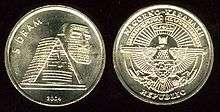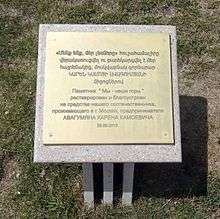We Are Our Mountains
"We Are Our Mountains" (Armenian: Մենք ենք, մեր լեռները, Menk' enk' mer lernerə) is a large monument north of Stepanakert, the capital city of the de facto independent Republic of Artsakh (de jure Khankendi, within Republic of Azerbaijan).
.jpg)


The sculpture, completed in 1967 by Sargis Baghdasaryan, is widely regarded as a symbol of the Armenian heritage of Nagorno-Karabakh. The monument is made from volcanic tufa and depicts an old man and woman hewn from rock, representing the mountain people of Karabakh. It is also known as "tatik-papik" (տատիկ-պապիկ) in Armenian, which translates as "Grandmother and Grandfather". The sculpture is prominent in Artsakh's coat of arms.[1]
Eurovision image controversy
The use of the monument during a video clip preceding a performance at Eurovision Song Contest 2009 was the first of several political conflicts during the competition surrounding Armenia and Azerbaijan. The conflict stemmed from an introductory "postcard" video played before Armenia's performance in a semi-final round, which depicted the monument alongside other symbols of Armenia. Representatives from Azerbaijan complained to the European Broadcasting Union about the use of "We Are Our Mountains" in the Armenian intro, since the territory of Nagorno-Karabakh is de jure part of Azerbaijan.[2] In response to the complaint, the image was edited out of the video in the finals. However, Armenia retaliated for the decision by including multiple images of the monument in its voting presentation—on a video screen in the background, and on the back of their spokesperson, Sirusho's, clipboard.[3]
See also
References
- Coat of Arms
- Deasy, Kristin (2009-05-15). "Eurovision: A Melting-Pot Contest, Where Native Doesn't Always Mean Best". Radio Free Europe/Radio Liberty. Retrieved 2009-05-17.
- Krikorian, Onnik (2009-05-16). "Ethnic rivalry wins over kitsch in the Caucasus". Frontline Club. Retrieved 2008-09-17.
External links
| Wikimedia Commons has media related to We Are Our Mountains. |